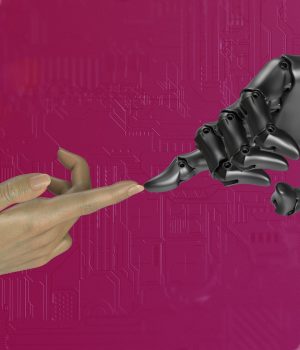Successful design thinking integrates an understanding of human behavior. What motivates people? How do they see themselves? What do they value? Applying core principles of the art/science of design is a good idea on different levels.
What can we learn from design about what to do to reach our goals in the world?
In this piece, we focus on the employee experience and digital transformations.
The anthropology of doing business as a human
As a student of philosophy, I’m always looking for ways in which I can apply the love for this old and broad field of knowledge to my professional life.
An important topic in philosophy is the question what it means to be human. Different possible answers to this question are covered in the field of philosophical anthropology.
In the first set of articles, I focused on the deeply human trait of storytelling. I wrote about the narrative that societies, people, and organizations tell about themselves. About storytelling as a way to communicate effectively about a specific business related topic – using appropriate technology.
After the pieces on storytelling I confronted two different worldviews, based on the writings of ancient Chinese philosophers, but that are still actual in these days.
Basically, I tried to present two different answers to the question: does hard work pay off? Can we conquer the universe by using calculations and rationalizations? Or are we victim to some cosmic joke where randomness rules?
The way we look at this as a human and an organization has far-reaching consequences for the actions we take towards the things around us. Maybe insights from the field of design can guide us how to do business.
And by doing business we mean being better human beings. After all, what better way to win the trust of the people who work for you or buy from you, than to try to be the best version of yourself?
How does design work?
To break down how design works – or doesn’t work – we can turn to the visionary The design of everyday things by Don Norman. While the first edition dates back to 1990, the idea’s that Norman spells out are more actual than ever, with designers nowadays encountering new challenges in the area of digital technology.
When it comes to the use of everyday objects we form a conceptual scheme about how something works. The scheme doesn’t have to be complete or even accurate as long as it is useful.
Conceptual models are often inferred from the device itself. The major clues to how things work come from their perceived structure. People create mental models of themselves, others, the environment, and the things with which they interact.
These same models serve as guides to help achieve our goals and understand the world. Paradoxically, the same technology that simplifies life by providing more functions in each device also complicates it by making the device harder to learn, harder to use.
This is the challenge for the designer.
We are only aware of the reflective level of conscious process, we tend to believe that all human thought is conscious. But it isn’t.
The most basic level of processing is called Visceral. This is sometimes referred to as “the lizard brain”. For Designers, the visceral response is about immediate perception. This has nothing to do with how usable, effective, or understandable the product is. It is all about attraction or repulsion.
The Behavioral is the home of the learned skills. Actions and analyses at this level are largely subconscious. For designers, the most critical aspect of the behavioral level is that every action is associated with an expectation. The information in the feedback loop of evaluation confirms or disconfirms the expectation, resulting in satisfaction or disappointment.
The Reflective level is the home of the conscious cognition. This is where deep understanding develops, where reasoning and conscious decision-making take place.
The design must take place at all levels: visceral, behavioral and reflective. To bridge the gap between what we would like to have done (our goals) and all possible physical actions to achieve those goals, we can identify seven stages of action: the goal, plan, specify, perform, perceive, interpret and compare.
We can associate these stages of action with the three different levels of processing as shown in the figure.
 From our experiences and the stories of others, we tend to generalize about the way people behave and things work – the conceptual models. We attribute causes to events, and as long as these cause-and-effect relationships make sense, we accept them and use them for understanding future events.
From our experiences and the stories of others, we tend to generalize about the way people behave and things work – the conceptual models. We attribute causes to events, and as long as these cause-and-effect relationships make sense, we accept them and use them for understanding future events.
Yet, these causal attributions are often erroneous. Conceptual models are often constructed from fragmentary evidence, with only a poor understanding of what is happening.
The kind of psychology that is applied postulates causes, mechanisms, and relationships where there are none.
Benefits of design thinking for an organization
We’ll explore two different areas where design thinking can benefit an organization: improving the employee experience and designing digital technology.
In order to be able to approach those two areas from the standpoint of design thinking we would like to put forward the following working definition:
Design thinking is the development of products and processes taking into account the three levels of processing that are crucial in the art/science of design: visceral, behavioral, reflective.
The employee experience
The most recent human capital trends report by Deloitte is titled Different by design. As you have noticed the word design is in the title. It is the overarching theme in the report which is based on surveys in HR departments around the world.
Design thinking provides a means to focus on the employee’s personal experience and to create processes centered upon the worker. The result: new solutions and tools that directly contribute to employee satisfaction, productivity, and enjoyment. – Deloitte HC Trends
This also means that HR’s role is expanding beyond its traditional focus on talent management, process, and transactions. HR is becoming an innovative consultant with a broader responsibility to design, simplify, and improve the entire employee and candidate experience.
One way of improving this experience can be to set up a platform that offloads the overwhelmed employee from the information overload and the always-connected 24/7 work environment that undermines productivity and contributes to low employee engagement.
Leading HR organizations are studying people to help develop interventions, apps, and tools that help make employees less stressed and more productive. On all levels of the organization.
This means first and foremost, we must take away things that can cause negative visceral reactions. Second, make sure we meet expectations to satisfy the behavioral processing in our interactions with the firm.
Once these two levels of processing give the employee a positive and satisfied feeling, the reflective part of the brain will link a positive story to the experience that is in line with the more primitive, unconscious activities in the brain.
Design thinking in digital transformation projects
One way to make the employee experience more smooth is with a wide range of apps built with cloud and analytics technology behind the scenes. This platform could support hundreds of apps: from attendance to employee wellness, from recruitment to collaboration, and more.
But it goes further than HR. You could also use this approach in management accounting and business intelligence. Design thinking relies on our ability to be intuitive, to recognize patterns, to construct ideas that have emotional meaning as well as being functional.
It also allows us to express ourselves in media other than words or symbols.
Nobody wants to run an organization on feeling, intuition, and inspiration. Yet an over-reliance on the rational and the analytical is just as risky. Design thinking, the integrated approach at the core of the design process, provides a third way.
The design of the dashboards and reports should entice a positive visceral response and be intuitive and easy to use. This ensures the reflective mind seamless access to the data and prevents the technology from getting in the way of the decision-making process.
How to do this in practice? Pixel-perfect layout, intuitive mapping of the functionality, correct implementation ensuring a performant interaction; it’s simple (but not easy).
How do you apply design thinking into your business? Share it with me in the comments below!
For more business tips, check our entrepreneurship section and subscribe to our weekly newsletters.






